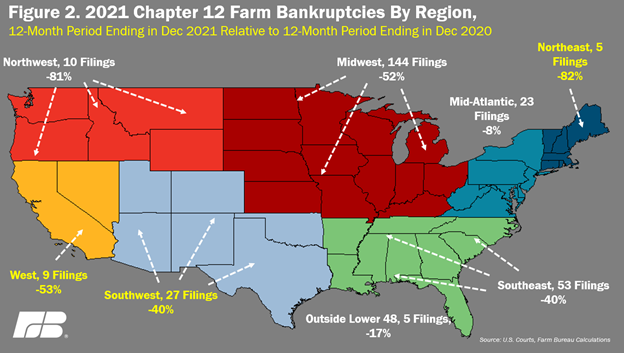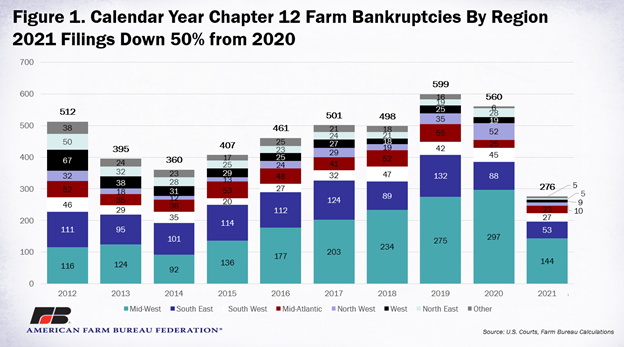
After three years with significant increases in farm bankruptcies, Chapter 12 filings dropped dramatically in 2021.
The number of Chapter 12 filings in 2021 is the lowest in the last decade and 50% lower than in 2020. This is the first time in at least 10 years that there were fewer than 300 filings.
Farm bankruptcies by region
Chapter 12 bankruptcies were down in every region last year. The region with the largest percentage decrease in filings was the Northeast, which saw a decrease of 82% from 2020.
The Midwest had the largest decrease in Chapter 12 filings by number, down from 297 filings to 144 in 2021. The Midwest still leads all regions in the number of filings, accounting for 52% of all farm bankruptcy filings in the U.S.

Wisconsin and Minnesota led the nation in farm bankruptcy filings.
“Given the significant challenges experienced in the dairy sector over the last many years, the concentration of dairies in these two states, and the consolidation of dairy operations in these states, it seems likely that many of the bankruptcy filings are on dairy operations,” says Veronica Nigh, Senior Economist for the American Farm Bureau Federation.
Nigh emphasizes that filing for bankruptcy does not necessarily mean that a farm will go out of business. “It is our hope that the protections and structure provided under a Chapter 12 filing would allow those operations to get back on their feet,” she says.
A look ahead
Net farm income has been incredibly volatile over the last decade. Net farm income in 2021 was around $119 billion, up from $95 billion in 2020. USDA currently projects $95.2 billion in returns this year.
Last year many producers saw a substantial increase in income from crop and livestock sales, but input costs moving forward could swing the story in a different direction.
“Many farmers are concerned that higher prices for their crops will retreat faster than higher costs for their inputs, putting farm profitability under stress,” says Nigh. “Those operations that have experienced multiple years of financial stress will be those most at risk this year.”
Learn more about 2021 farm bankruptcy trends from Farm Bureau here.

About the Author(s)
You May Also Like






